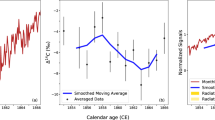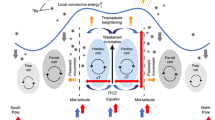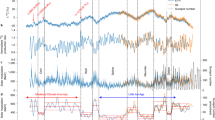Abstract
The glacial oscillations which dominate the Quaternary global climate are closely related to changes in incoming solar radiation, but the details of palaeoclimatic spectra suggest that other parameters, usually referred to as feedback, have significantly increased the climatic response to extraterrestrial forcing1. The last deglaciation appears to be one of the more characteristic examples of nonlinearity because its abruptness strongly contrasts with the smooth shape of the associated solar radiation maximum dated at ∼11,000 yr BP. In addition, the presence of the Younger Dryas cold event, concomitant with the solar radiation maximum, could be interpreted as a transitory phenomenon caused by the rapid meltwater influx linked to the first phase of the ice-sheet's disintegration2,3. Here, using accelerator mass spectrometry, we date precisely the movements of the polar front during the whole period of glacial retreat ∼15,000–8,000 yr BP. Our results show that the polar front has moved between 35° N and 55° N in < 1,000 yr for the earliest retreat ∼12,500–12,000 BP and moved almost 'instantaneously' (that is < 400 yr) during the two abrupt climatic changes associated with the Younger Dry as cold event.
This is a preview of subscription content, access via your institution
Access options
Subscribe to this journal
Receive 51 print issues and online access
$199.00 per year
only $3.90 per issue
Buy this article
- Purchase on Springer Link
- Instant access to full article PDF
Prices may be subject to local taxes which are calculated during checkout
Similar content being viewed by others
References
1. Ruddiman, W. F. & Duplessy, J. C. Quat. Res. 23, 1–17 (1985). 2. Broecker, W. S., Peteet, D. M. & Rind, D. Nature 315, 21–25 (1985). 3. Ruddiman, W. F. & Mclntyre, A. Palaeogeogr. Palaeoclimatol. Palaeoecol. 35,145–214 (1981). 4. Imbrie, J. & Kipp, N. D. in The Late Cenozoic Glacial Ages 71–181 (ed. Turekian, K. K. (Yale University Press, New Haven, 1971), 5. Pujol, C. thesis, Univ. Bordeaux (1980). 6. Duplessy, J. C., Labeyrie, L. D. & Shackleton, J. N. Eos 66, 18 (1985). 7. Arnold, M., Bard, E., Maurice, P. & Duplessy, J. C. Nuclear Instr. Meth. Phys. Res. (in the press). 8. Andree, M. et al dim. Dyn. 1, 53–62 (1986). 9. Bard, E., Arnold, M., Duprat, J., Moyes, J. & Duplessy, J. C. Clim. Dyn. 1, 101–112 (1987). 10. Duplessy, J. C., Delibrias, G., Turon, J. L., Pujol, C. & Duprat, J. Palaeogeogr. Palaeoclimatol Palaeoecol. 35, 121–144 (1981). 11. Duplessy, J. C. et al. Nature 320, 350–352 (1986). 12. CLIMAP Science 191, 1131–1137 (1976). 13. CLIMAP Geol. Soc. Am. Map Chart Ser. MC–36 (1981). 14. Ruddiman, W. F., Sancetta, C. D. & Mclntyre, A. Phil. Trans. R. Soc. B280, 119–142 (1977). 15. Broecker et al. Paleooceanography (submitted 1987). 16. Jalut, G., Delibrias, G., Dagnac, J., Mardonnes, M. & Bouhours, M. Palaeogeogr. Palaeoclimatol Palaeoecol. 40, 321–359 (1982). 17. Mardonnes, M. & Jalut, G. Pollen Spores XXV, 163–212 (1983). 18. Andree, M., Oeschger, H., Siegenthaler, U., Riesen, T. & Moell, M. Radiocarbon. 28,411–416 (1986). 19. Mangerud, J., Andersen, S. T., Berglund, B. & Donner, J. J. Boreas 3, 109–126 (1974). 20. Welten, M. Sch. Naturforsch Gesellschaft. 95, 7–104 (1982). 21. Woillard, G. Acta geographica lovanensia 14, 168 pages (1975). 22. Watts, W. A. in The Late–glacial of North–West Europe 1–21 (eds Lowe, J. J., Gray, J. M. & Robinson, J. E.) (Pergamon, Oxford, 1980). 23. Coope, G. R., Brophy, J. A. Boreas 1, 97–142 (1972). 24. Coope, G. R., Joachim, M. J. in The Late–glacial of North–West Europe 55–68 (eds Lowe, J. J., Gray, J. M. & Robinson, J. E.) (Pergamon, Oxford, 1980). 25. Atkinson, T. C., Briffa, K. R. & Coope, G. R. Nature 325, 587–592 (1987). 26. Peacock, J. D., Graham, D. K. & Wilkinson, I. P. Inst. geol. Sci. Rep. IS/11, (1978). 27. Peacock, J. D. Boreas 12, 73–82 (1983). 28. Sejrup, H. P., Holtedahl, H., Norvik, O. & Miljeteig, I. Boreas 9, 203–207 (1980). 29. Mangerud, J. Nor. Geol. Tidsskr. 57, 23–54 (1977). 30. Rind, D. Peteet, D. Quat. Res. 24, 1–22 (1985). 31. Rind, D., Peteet, D., Broecker, W. W. Mclntyre, A. & Ruddiman, W. Clim. Dyn. 1, 3–33 (1986).
Author information
Authors and Affiliations
Rights and permissions
About this article
Cite this article
Bard, E., Arnold, M., Maurice, P. et al. Retreat velocity of the North Atlantic polar front during the last deglaciation determined by 14C accelerator mass spectrometry. Nature 328, 791–794 (1987). https://doi.org/10.1038/328791a0
Received:
Accepted:
Issue Date:
DOI: https://doi.org/10.1038/328791a0
This article is cited by
-
Seasonal origin of the thermal maxima at the Holocene and the last interglacial
Nature (2021)
-
Mesolithic human occupation and seasonality: sclerochronology, δ18O isotope geochemistry, and diagenesis verification by Raman and LA-ICP-MS analysis of Argyrosomus regius (meagre) sagittae otoliths from layer 1 of Cabeço da Amoreira Mesolithic shell midden (Muge, Portugal)
Archaeological and Anthropological Sciences (2019)
-
Consistently dated Atlantic sediment cores over the last 40 thousand years
Scientific Data (2019)
-
A quick cooling event of the East Asian monsoon responding to Heinrich Event 1: Evidence from stalagmite δ18O records
Science in China Series D: Earth Sciences (2002)
-
The timing of the last deglaciation in North Atlantic climate records
Nature (2001)
Comments
By submitting a comment you agree to abide by our Terms and Community Guidelines. If you find something abusive or that does not comply with our terms or guidelines please flag it as inappropriate.



